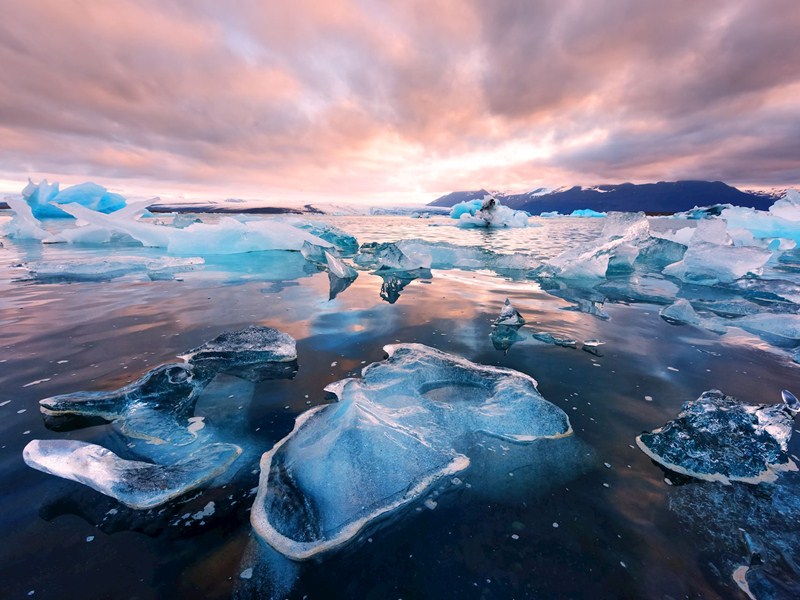Where:
Iceland – teetering on the edge of the Arctic, only a three-hour flight from the UK, this staggeringly beautiful country is home to some of the world’s greatest natural wonders. Feel the power of immense waterfalls tumbling into mighty rivers, travel through dramatic landscapes crafted by thousands of years of volcanic activity, admire the biggest ice cap outside of the poles or journey into the remote countryside for a once-in-a-lifetime opportunity to witness the incredible northern lights dancing across the night sky.
When:
Iceland’s far north ocean location makes for fluctuating weather. May-Sep is the best time to visit Iceland if you want to go whale watching; you can combine orcas with Northern Lights in late Sep. Jun-Aug offer endless days, low 20s warmth plus summer festivals. Dry weather inland makes this prime hiking season. Snow comes as early as Sep (and can linger to May) but Iceland can look good too in autumn. Winters can be brutal – but offer the aurora borealis for the long dark hours. Winter road closures make access to some areas difficult.
South Iceland & Reykjav�k
The south is Iceland’s most travelled region and it’s easy to see why. The world’s northernmost capital, Reykjav�k, offers a thriving cultural scene, and the winter months bring an extra reason to visit – the colourful aurora borealis, which light up the skies from late September to early April.
The Golden Circle is the South’s most easily accessible collection of natural wonders, just an hour or so from the capital. This grand trio comprises the bubbling fumaroles and steamy eruptions of Geysir, thundering Gullfoss waterfall and ancient �ingvellir National Park – the meeting point of the North American and Eurasian continental plates. Head further south to the black sand beaches, where the pounding Atlantic surf has eroded 100-metre lava cliffs into dramatic rock pillars, and breeding pairs of puffins are found here in the summer months. Further east, immense Vatnaj�kull glacier dominates the rugged landscape, with the giant floating icebergs of J�kuls�rl�n glacial lagoon its crowning glory.
West Iceland & the Westfjords
West Iceland is a microcosm of the country; head north from Reykjav�k and you’ll soon encounter mystical mountains, bubbling hot pools, colourful fishing villages and Viking legends, not to mention wildlife in abundance with noisy seal colonies, steep puffin cliffs and whale watching. The enchanting Sn�fellsnes National Park is the highlight of the west, with the imposing Sn�fellsj�kull at its centre. This 700,000-year-old stratovolcano with a glacier covering its summit provides the perfect opportunity to explore, with easy hiking trails criss-crossing the lava fields.
The remote Westfjords peninsula is best known for its incredibly intricate coastline, containing more than half the fjords in Iceland. Th steep vertical cliffs of the fjords are home to several million sea birds, and Latrabjarg – Europe’s westernmost point – is one of the best places to see them. These cliffs are home to puffins, guillemots and the largest colony of razorbills in the world, estimated to be close to half a million.
North Iceland
North Iceland boasts some of the country’s biggest attractions. Dettifoss waterfall is the most powerful waterfall in Europe, while the fishing town of H�sav�k is known as Iceland’s whale watching capital.
Lake M�vatn is the region’s biggest draw; created by a large basaltic lava eruption 2,300 years ago, the shallow lake and its islands are surrounded by volcanic landforms’ including black lava
fields, cones and calderas, as well as wetlands which attract huge numbers of ducks. The area’s nature Baths are a less touristy alternative to the Blue Lagoon – enjoy a relaxing dip amidst clouds of steam rising from a fissure deep in the Earth’s surface or swim in a pool of geothermal water drawn from depths of up to 2,500 metres.
East Iceland
The first part of Iceland to be discovered by the Vikings, the East is an untamed wilderness of mountains, fjords, deserts and forest. With the ring road clinging to the intricately carved inlets of the fjordland, isolated fishing villages of just a few hundred people emerge between each set of steep cliffs. A comprehensive network of hiking trails cross the mountains between the fourteen fjords, rewarding walkers with spectacular views across the dramatic coastline.
Carved by an Ice Age glacier, Sey�isfj�r�ur is the scenic location of a picturesque fishing village which begs to be explored. The colourful Norwegian-style wooden houses dating from the early 20th century bring the history of the village to life, while walking into the surrounding hills provides breath-taking views over the fjord below.
Further south, the setting of Dj�pivogur – or Deep Bay – village is one of incomparable natural beauty. Teetering on the very edge of the headland, this pretty village is decorated by tiny boats and historic houses which date back to the fishing industry of the early 1700s. Relax in the geothermal hot tubs at the village’s outdoor swimming pool – one of many which can be found in the communities of the East Fjords, no matter how small the local population.
By air from the UK to Reykjavik is approximately 3 hours flying time.�For more details, ask about Regent Holidays at Baldwins Travel Group.
www.baldwinstravel.co.uk
#HolidayInspirations








